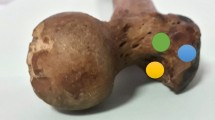Abstract
Background
Previous studies report that children above the 95th percentile in weight for their age had an increased risk for complications following titanium elastic nailing for femur fractures. The purpose of this study is to examine whether obesity, defined as body mass index (BMI) > 95th percentile, and/or simple weight correlates with an increased rate of complications.
Methods
The incidence of complications was compared between obese and non-obese patients and also between patients who weighed ≥50 kg and those <50 kg.
Results
The overall complication rate was 23% (16/71). The complication rate was 17% (10/58) for “non-obese” patients and 46% (6/13) for “obese” patients. This difference was statistically significant (P = 0.03). The complication rate was 46% (6/13) in children who weighed ≥50 kg and 17% (10/58) in children who weighed <50 kg. This difference was also statistically significant (P = 0.03).
Conclusions
This study demonstrates that obesity (BMI > 95th percentile) and weight over 50 kg predispose patients to increased risk of surgical complications when undergoing flexible elastic nailing for femur fractures. Both obese children and children weighing ≥50 kg were two times more likely to have a complication when undergoing this procedure.
Similar content being viewed by others
References
Yanovski JA (2001) Pediatric obesity. Rev Endocr Metab Disord 2(4):371–383. doi: 10.1023/A:1011800532068
Leet AI, Pichard CP, Ain MC (2005) Surgical treatment of femoral fractures in obese children: does excessive body weight increase the rate of complications? J Bone Joint Surg Am 87(12):2609–2613. doi: 10.2106/JBJS.D.02019
Taylor ED, Theim KR, Mirch MC, Ghorbani S, Tanofsky-Kraff M, Adler-Wailes DC et al (2006) Orthopedic complications of overweight in children and adolescents. Pediatrics 117(6):2167–2174. doi: 10.1542/peds.2005-1832
Foran JR, Mont MA, Rajadhyaksha AD, Jones LC, Etienne G, Hungerford DS (2004) Total knee arthroplasty in obese patients: a comparison with a matched control group. J Arthroplasty 19(7):817–824. doi: 10.1016/j.arth.2004.03.017
Green E, Lubahn JD, Evans J (2005) Risk factors, treatment, and outcomes associated with nonunion of the midshaft humerus fracture. J Surg Orthop Adv 14(2):64–72
Jupiter JB, Ring D, Rosen H (1995) The complications and difficulties of management of nonunion in the severely obese. J Orthop Trauma 9(5):363–370. doi: 10.1097/00005131-199505000-00001
Karunakar MA, Shah SN, Jerabek S (2005) Body mass index as a predictor of complications after operative treatment of acetabular fractures. J Bone Joint Surg Am 87(7):1498–1502. doi: 10.2106/JBJS.D.02258
Namba RS, Paxton L, Fithian DC, Stone ML (2005) Obesity and perioperative morbidity in total hip and total knee arthroplasty patients. J Arthroplasty 20(7 Suppl 3):46–50. doi: 10.1016/j.arth.2005.04.023
McKee MD, Waddell JP (1994) Intramedullary nailing of femoral fractures in morbidly obese patients. J Trauma 36(2):208–210. doi: 10.1097/00005373-199402000-00011
Foran JR, Mont MA, Etienne G, Jones LC, Hungerford DS (2004) The outcome of total knee arthroplasty in obese patients. J Bone Joint Surg Am 86-A(8):1609–1615
Brenn BR (2005) Anesthesia for pediatric obesity. Anesthesiol Clin North America 23(4):745–764
Setzer N, Saade E (2007) Childhood obesity and anesthetic morbidity. Paediatr Anaesth 17(4):321–326. doi: 10.1111/j.1460-9592.2006.02128.x
Ho CA, Skaggs DL, Tang CW, Kay RM (2006) Use of flexible intramedullary nails in pediatric femur fractures. J Pediatr Orthop 26(4):497–504
Moroz LA, Launay F, Kocher MS, Newton PO, Frick SL, Sponseller PD et al (2006) Titanium elastic nailing of fractures of the femur in children. Predictors of complications and poor outcome. J Bone Joint Surg Br 88(10):1361–1366. doi: 10.1302/0301-620X.88B10.17517
Wall EJ, Jain V, Vora V, Mehlman CT, Crawford AH (2008) Complications of titanium and stainless steel elastic nail fixation of pediatric femoral fractures. J Bone Joint Surg Am 90(6):1305–1313. doi: 10.2106/JBJS.G.00328
Author information
Authors and Affiliations
Corresponding author
About this article
Cite this article
Weiss, J.M., Choi, P., Ghatan, C. et al. Complications with flexible nailing of femur fractures more than double with child obesity and weight >50 kg. J Child Orthop 3, 53–58 (2009). https://doi.org/10.1007/s11832-008-0149-2
Received:
Accepted:
Published:
Issue Date:
DOI: https://doi.org/10.1007/s11832-008-0149-2




